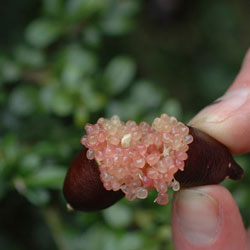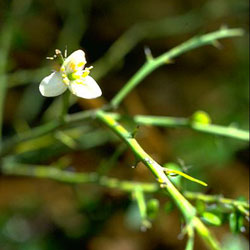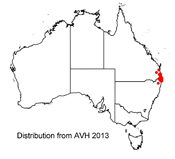Citrus australasica
 |
 |
Australian Finger Lime
The Australian Finger Lime, Citrus australasica, belongs to the Rutaceae family, which includes all forms of citrus fruits. It occurs along the east coast of Australia, ranging mainly from south east Queensland to north-east New South Wales in tropical to subtropical rainforest communities.
 C. australasica is a large shrub to small tree up to 6 m tall, with spines up to 25mm long. The leaves have many aromatic oil glands. Flowers are commonly white, but can also be pale pink. The elongated cylindrical fruits may be green, yellow, black, brown or purple producing flesh that is green, yellow or pink. The fruit has a high commercial value because of its distinctive caviar appearance and tangy taste, making it a desirable species of Citrus to grow. There are currently 5 registered finger lime cultivars including Citrus australasica ‘Alstonville’, Citrus australasica ‘Blunobia Pink Crystal’, Citrus australasica ‘Durhams Emerald, Citrus australasica ‘Judy’s Everbearing’ and Citrus australasica ‘Pink Ice'.
C. australasica is a large shrub to small tree up to 6 m tall, with spines up to 25mm long. The leaves have many aromatic oil glands. Flowers are commonly white, but can also be pale pink. The elongated cylindrical fruits may be green, yellow, black, brown or purple producing flesh that is green, yellow or pink. The fruit has a high commercial value because of its distinctive caviar appearance and tangy taste, making it a desirable species of Citrus to grow. There are currently 5 registered finger lime cultivars including Citrus australasica ‘Alstonville’, Citrus australasica ‘Blunobia Pink Crystal’, Citrus australasica ‘Durhams Emerald, Citrus australasica ‘Judy’s Everbearing’ and Citrus australasica ‘Pink Ice'.
Citrus australasica can be grown on a wide range of soils in tropical and subtropical rainforest communities. In temperate areas, deep loamy soils with adequate irrigation are ideal. Soil should be nutrient rich, with high levels of organic matter with slightly acidic soil. It is able to withstand light frost levels. In cooler climates, a semi shaded area in a north facing site is preferred. Mulch during spring and have a good water regime to keep soil moist during summer and lightly prune annually after fruiting in autumn. No fertiliser is required for maintenance.
It is possible to be grown from seed, cuttings or grafting onto exotic citrus species. C. australasica is slow growing, and if grown from seed it may take up to 15 years to reach maturity. It is essential that the seed used is as fresh as possible to maximize success rates. Semi-hardwood cuttings, like seedlings, have a very slow growth rate and low success rate. Root hormone is required when growing C. australasica from a cutting to help development. Ideally cuttings and seedlings should be grown in 100 litre containers. When grafted onto exotic citrus, species mature faster and are able to withstand other soil and climatic conditions. The most common exotic species they are grafted to are Citrus trifoliata and Troyer citrange.
Citrus australasica flowers late autumn to summer, with the fruit ripening between May and June.
Due to undesirable climatic conditions, the flowering and fruiting ability is significantly decreased in areas south of Sydney. A number of pests including aphids, caterpillars, grasshoppers affect C. australasica. The fungal disease Melanose (Diaporthe citri), oleocellosis, where oil is released from damaged oil glands, and environmental damage from the wind and sun are also problems that may be encountered.
Stephanie Creer, Botanical Intern 2013
Name meaning: Citrus australasicaCitrus - derived from the Ancient Greek word ‘citron’, in turn derived from the word ‘kédros’, meaning cedar in Ancient Greek as cedar and citrus fruit and leaves share a related scent. australasica - southern, referring to its Australian origin. |
References:
ANPSA. (2007) Citrus australasica, Australian Native Plant Society Australia. Available at http://anpsa.org.au/c-aust.html [accessed 10/2/13]
Bonney, N. (2010) Knowing, Growing, Eating - Edible Wild Native Plants for Southern Australia. Tantanoola, S.A.
Hardy, S.; Wilk, P.; Viola, J. & Rennie, S.(2010) Growing Australian Native Finger Limes. Prime facts for profitable, adaptive and sustainable primary industries 979. Department of Industry and Investment, NSW. Available at http://www.dpi.nsw.gov.au/__data/assets/pdf_file/0016/320272/growing-australian-native-finger-limes.pdf [accessed 10/2/13]
McGeever, S. (1998) Citrus australasica. The Bushfoods Starter Kit – A Resource Guide for Growers, Processors, Chefs and Buyers. Australian Bushfoods magazine, Qld.
Richards, P.G. & Harden, G.J. (2012) Citrus australasica, PlantNet – New South Wales Flora Online. Available at http://plantnet.rbgsyd.nsw.gov.au/cgi-bin/NSWfl.pl?page=nswfl&lvl=sp&name=Citrus~australasica [accessed 31/1/13]
![An Australian Government Initiative [logo]](/images/austgovt_brown_90px.gif)

